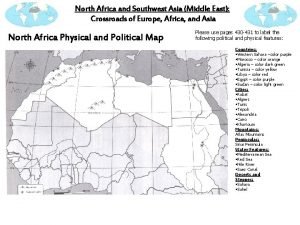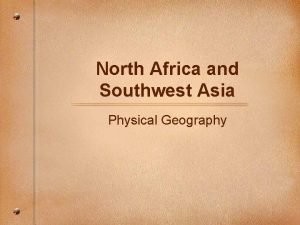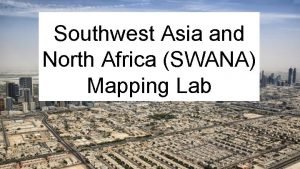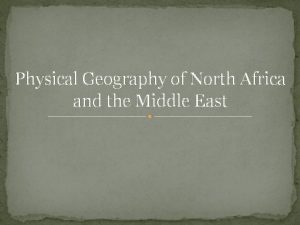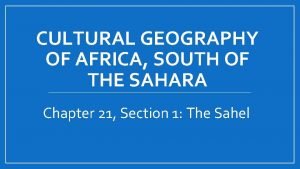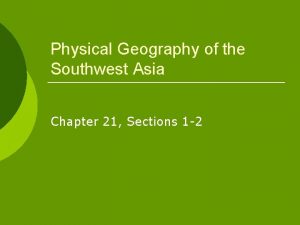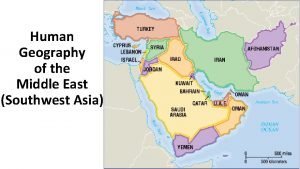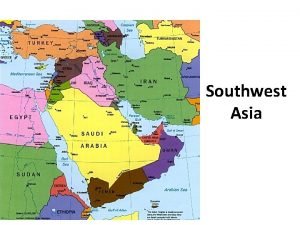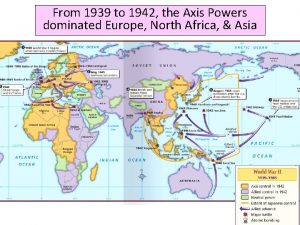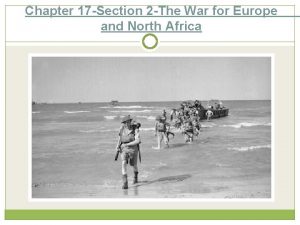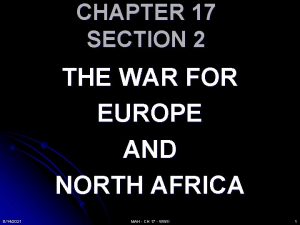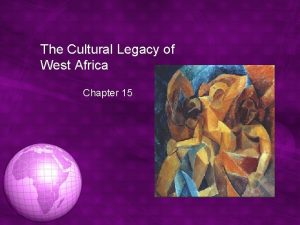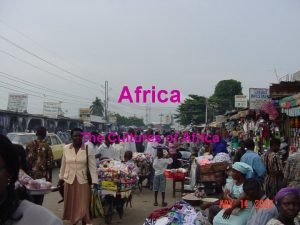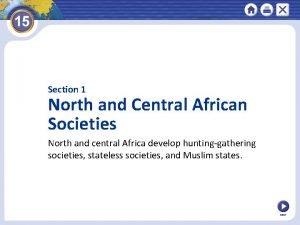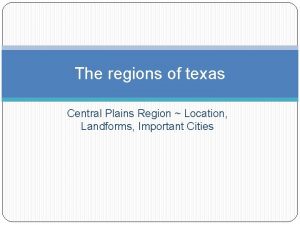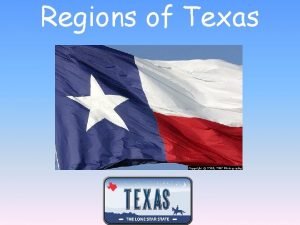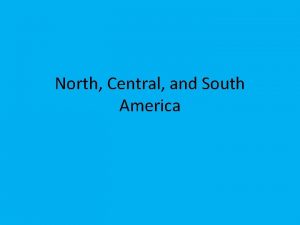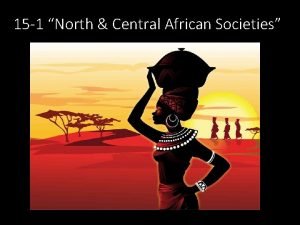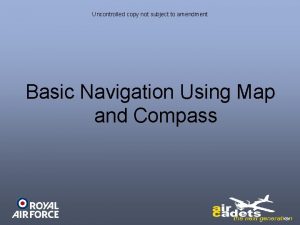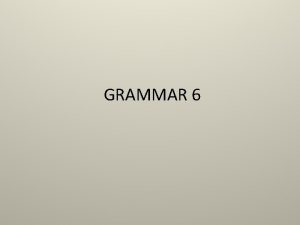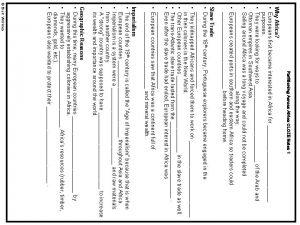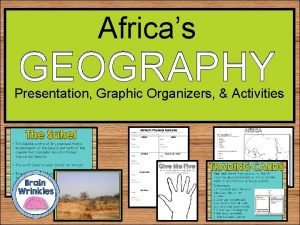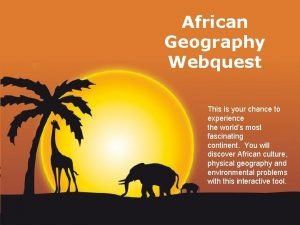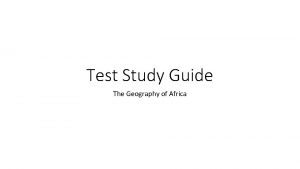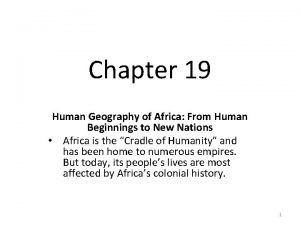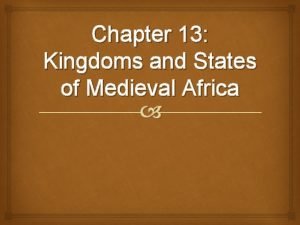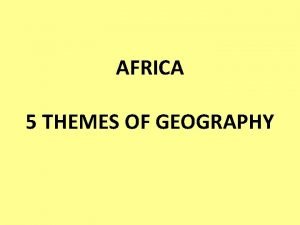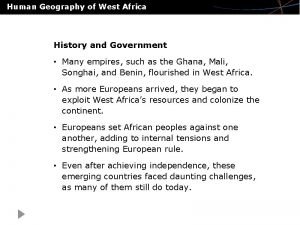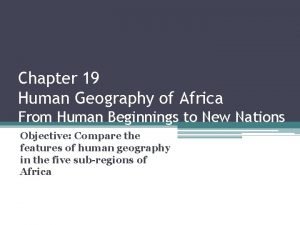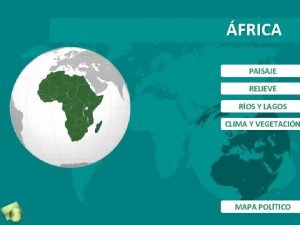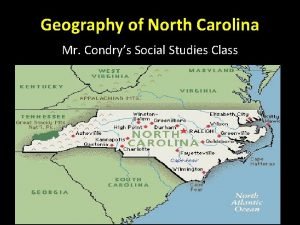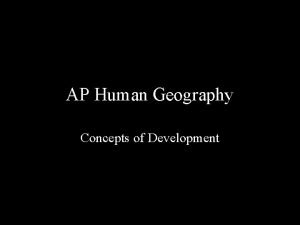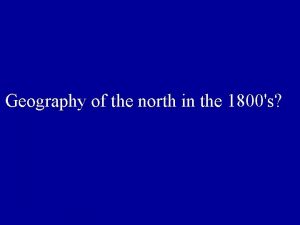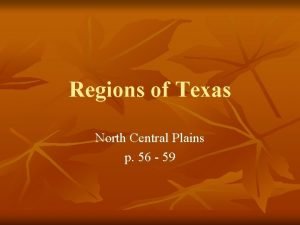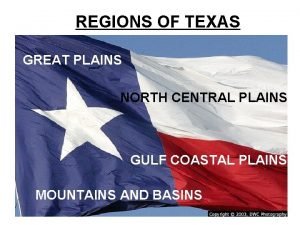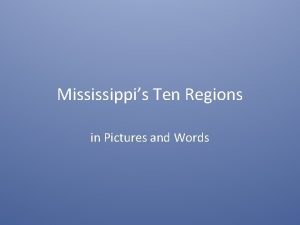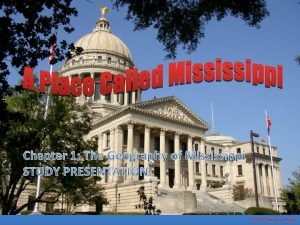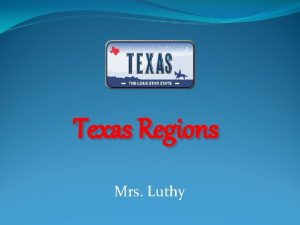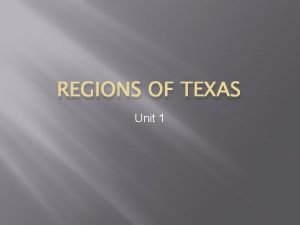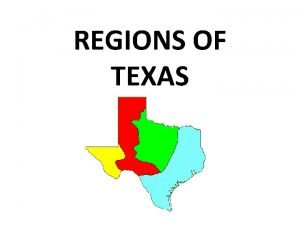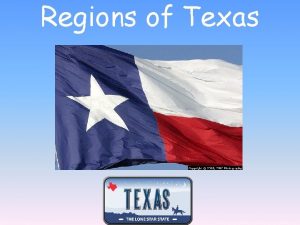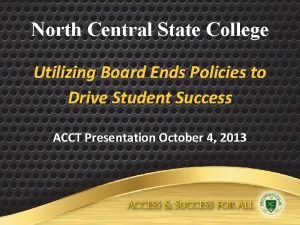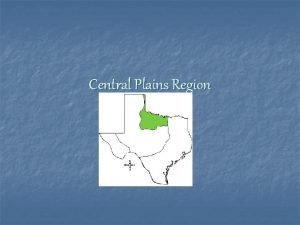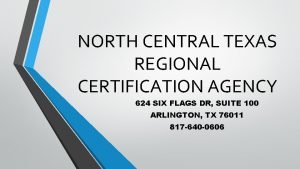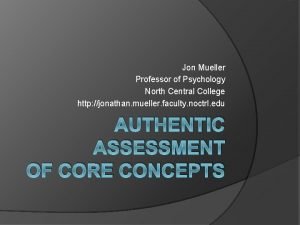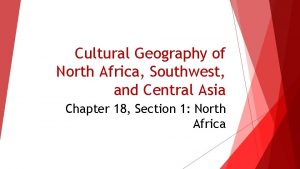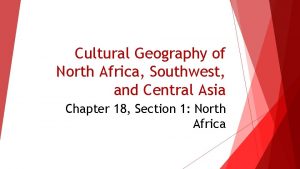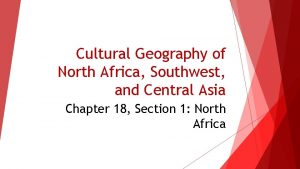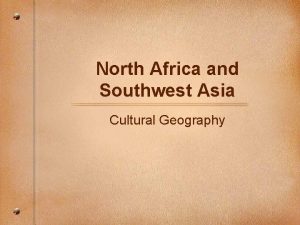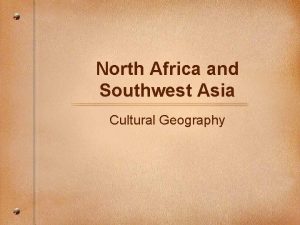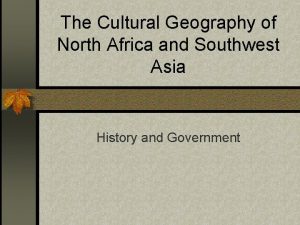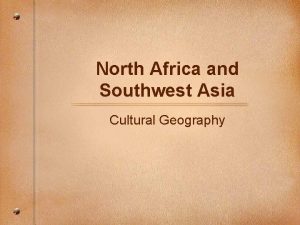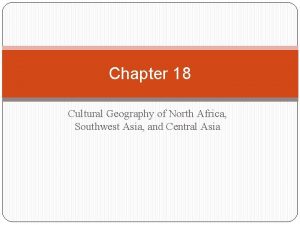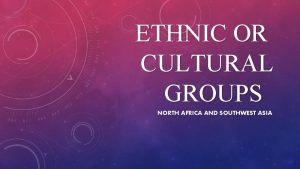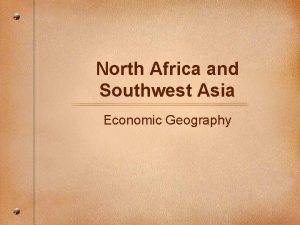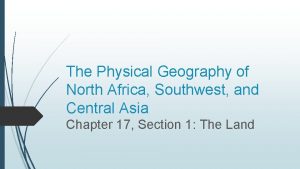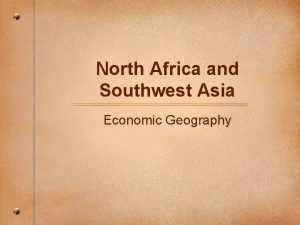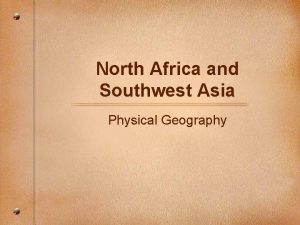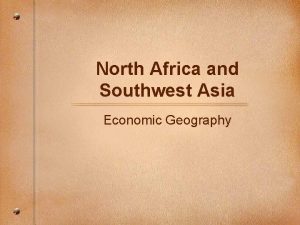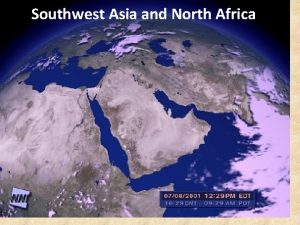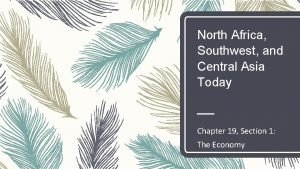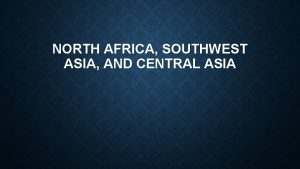Cultural Geography of North Africa Southwest and Central























































- Slides: 55

Cultural Geography of North Africa, Southwest, and Central Asia Chapter 18, Section 1: North Africa

Important Vocabulary Nomad: groups of people who move from place to place depending on the season and availability of grass for grazing and water. Bedouin: Arabic-speaking people who migrated to North Africa from deserts in Southwest Asia. Infrastructure: basic urban necessities such as streets and utilities.

Vocabulary (Cont’d) Domesticate: adapting plants and animals for uses of food, clothes, and transportation. Hieroglyphics: a form of picture writing developed in Ancient Egypt. Geometric Boundary: following straight lines and doesn’t account for natural and cultural features. Exist between Libya, Algeria, and Egypt.

Vocabulary (Cont’d) Nationalism: a belief in the right of an ethnic group to have its own independent country. Trend in North Africa during 1800 s.

Map of North Africa

The Population Primary influences were mix of indigenous people (Berbers) and Arab cultures. Arabs first migrated in the 600 s. Europeans have influenced the region’s culture. Settlements mainly along seacoasts and rivers. Major population centers: Casablanca, Morocco; Tunis, Tunisia; Algiers, Algeria; Tripoli, Libya; Cairo, Egypt.

Early Civilizations Farming communities along the Nile River by 6, 000 B. C. Ancient Egyptian civilization developed 6, 000 years ago. Ancient Egypt developed calendars, buildings, pyramids, and hieroglyphics.

Invasions Arab invasions in the 7 th century. After brief Byzantine and Vandal invasions, Arab rule cemented. European colonial rule affected area. Well-educated urban middleclass adopted nationalism.

Independence Egypt gained independence from the U. K. in 1922. Morocco gained independence from France in 1956. Algeria gained independence from France in 1962. Libya gained independence from Italy in 1951. Colonel Muammar Qaddafi came to power in 1969 coup.

Culture Islam is the region’s main religion. Arabic language is mainly spoken. Most youths attend school, and primary education is free. Literacy rate is 50% in Morocco and 82% in Libya. Hospitals are gov’t-owned. Arts: weaving, embroidery, and metal-working.

Cultural Geography of North Africa, Southwest, and Central Asia Chapter 18, Section 2: The Eastern Mediterranean

Important Vocabulary Monotheism: the belief in one God. Prophet: a religious messenger. Mosque: a Muslim house of worship.

Map of Eastern Mediterranean

The Population 7. 6 million people live in the Eastern Mediterranean. 80% of Israel’s population is Jewish. Israel was founded as a Jewish state in 1948. Arabs (Palestinians) in region didn’t want a Jewish state. Very high population densities. Over 80% of people live in cities.

Early Civilizations Elba, Syria was an important commercial center in 3, 000 B. C. The Semitic Empire around 2, 400 B. C. Damascus, Syria is one of the oldest cities in the world.

History of Judaism One of the oldest monotheistic faiths. Jews trace their ancestors to the ancient Israelites. Judaism teaches obedience in God’s laws. Hebrew Bible is the Torah.

History of Christianity Jesus began his ministry around 30 A. D. His followers believed he was the Son of Man. Jesus died for mankind’s sins. Christian Bible contains the Hebrew Bible.

History of Islam In 610 A. D. God came to Muhammad in Mecca. He preached people should not sin and follow God. By the 700 s, the religion spread throughout the region.

Independence & Conflict By the late 1800 s, Western European powers controlled the area. Lebanon gained its independence in 1943, and Syria in 1946 from France. Jordan gained its independence from the British in 1946.

Arab-Israeli Conflict The Romans expelled the Jews from their homeland. In 1947, the U. N. planned to create a Jewish and Arab state in Palestine. After British withdrawal in 1948, the Jews created the state of Israel.

The Conflict (Cont’d) Arab opposition led to six wars over a 25 -year period. The 1967 war gave Israel control of the West Bank and Gaza Strip. Peace efforts in the 1990 s. Efforts stalled with Hamas’ electoral victory in 2006.

Culture The majority follow the Sunni Islam faith. Family The life includes the extended family and worship. languages spoken are Arabic, Hebrew, and English. Education Literacy is free and compulsory. rates vary from 79% in Syria to 97% in Israel. Most hospitals are gov’t-owned. Rich history or arts, architecture, and sacred writings.

Cultural Geography of North Africa, Southwest, and Central Asia Chapter 18, Section 3: The Northeast

Important Vocabulary Culture Hearth: center where cultures developed and spread. Ancient Mesopotamia. Cuneiform: wedge-shaped symbols written on clay tablets. Sumerians. Qanats: underground canals. Persian Empire.

Vocabulary (Cont’d) Natural Boundary: a physical boundary, like mountains. Embargo: a ban on trade. Ziggurat: large, mud-brick temples.

The Turks Turkic peoples migrated there from Central Asia in the 1, 000 s. The Ottoman Turks created the Ottoman Empire. The Turks practice Islam and speak Turkish.

The Iranians A population of 73 million people; once called Persia. Indo-Europeans from Russia migrated there around 1, 000 B. C. Iranians speak Farsi and practice Shia Islam.

Arabs Most live in Iraqis practice Shia Islam, about 35% Sunni. Arabic is the main language spoken.

The Kurds They live in the mountainous regions of Iraq, Iran, and Turkey. Most Kurds are Sunni Muslims and speak Kurdish. They have different customs and dress compared to other Arabs.

Density & Distribution Over 70 million people live in Turkey and 30 million in Iraq. Istanbul, Turkey; Tehran, Iran; Baghdad, Iraq are the capitals and dominate the cultural life.

Ancient Mesopotamia The world’s first culture hearth. Known as “The Fertile Crescent. ” Home of the Sumerian civilization. Master farmers, created codes of law; math and engineering.

The Phoenicians They settled around 3, 000 B. C. They developed a new alphabet, basis for many modern alphabets.

The Persian Empire Inhabited the region during the 500 s B. C. The Qanats were a great engineering achievements.

Modern Times Iraq was under British control until 1932. Turkey was created in 1923 after the dissolution of the Ottoman Empire. Iran underwent an Islamic Revolution in 1979.

The Oil Era In the early 1900 s, oil was discovered in the Persian Gulf. The Gulf states formed OPEC in the late 1950 s, and agreed to regulate production. Anger over the Arab-Israeli War led to OPEC’s oil embargo in 1973.

Culture Education is required through grade 6 in Iraq and grade 9 in Turkey. Healthcare varies greatly in the region. Literature is based on oral traditions, epics, and poetry.

Cultural Geography of North Africa, Southwest, and Central Asia Chapter 18, Section 4: The Arabian Peninsula

Important Vocabulary Sheikhdom: territory ruled by an Islamic religious leader. Ex: U. A. E. Shari’ah: Islamic law based on the Qur’an. Ex: Saudi Arabia. Emir: a prince. Ex: Kuwait and Qatar.

Vocabulary (Cont’d) Hajj: a pilgrimage. Once in lifetime to Mecca. Ibadhism: a form of Islam practiced in Oman. A moderate conservatism.

Map of Arabian Peninsula

The People Most of the people (65 million) are Arab Muslims. They are descendent from Egyptians, Berbers, and Phoenicians. Kuwaitis are Arabs, but migrated to the region after the discovery of oil.

Density & Distribution In Bahrain, 89% live in 2 cities: Manama and Al Muharraq. In Oman, over 50% live in coastal areas. Most of the people in the U. A. E. are newly arrived. Foreign workers: 50% of Qatar’s and 60% of Kuwait’s population.

Early Cultures Vibrant cultures existed for over 5, 000 years. Ancient Greeks used Kuwait as a trade center for 2, 000 years. Saudi Arabia created in 1932.

Independence Kuwait gained its independence from Britain in the mid-1900 s. U. A. E. created in 1971. Saudi Arabia, Bahrain, and Oman are monarchies. Saudi Arabia follows Shari’ah Law. Oil-rich labor. nations need foreign

Religion & Language Majority are Muslims. Most believe in hajj. Some practice Wahhabism. Majority speak Arabic. English also spoken.

Culture Most children go to school, high literacy rates. Oman focuses heavily on a training workforce. Healthcare varies; hospitals are gov’t-owned. Well-known architecture with mosques and palaces. Religious holidays are very important.

Cultural Geography of North Africa, Southwest, and Central Asia Chapter 18, Section 5: Central Asia

Important Vocabulary Enclave: a territory this is culturally or ethnically different from the surrounding larger cultures. Ex: Armenia. Exclave: a distinct group of people who are isolated from the main part of the country. Ex: Azerbaijan. Mujahideen: Afghan freedom fighters.

Map of Central Asia

The People Pashtun is the main ethnic group in Afghanistan. Over 50 ethnic groups in the Caucasus region. Most Turkic peoples (outside of Turkey) live in Central Asia.

Density & Distribution Uneven distribution due to mountainous terrain. 28. 4 million people live in Afghanistan. Numerous conflicts have led to displaced people. Many people live and work in the river valleys.

Cultures & Conquests The Kingdom of Urartu was in the Caucasus region. Silk Road began in the 100 s B. C. The Ancient Greeks, Persians, Arabs, and Ottoman Turks also ruled the area.

Conquests (Cont’d) Central Asia fell under the control Genghis Khan and the Mongols in the 1200 s. The Russian Empire unified the area in the 1800 s, and fully under the former Soviet Union by 1936.

Independence The Central Asian states are now independent since the Soviet Union’s collapse. The U. S. S. R. invaded Afghanistan in 1979, but ultimately failed. The Taliban took over Afghanistan after defeating the Soviets until 2002.

Culture The vast majority speak a form of Turkic. Georgia has a different language and alphabet. Russian is still the official language in Kazakhstan. Sunni Islam is the main religion. In Georgia and Armenia, it is Christianity. Education Poor A varies greatly in the region. healthcare resources. rich literary tradition – many novelists.
 Kums definition geography
Kums definition geography Swana region
Swana region Political map of southwest asia and north africa
Political map of southwest asia and north africa North africa southwest asia physical map
North africa southwest asia physical map North africa and southwest asia mountains
North africa and southwest asia mountains Swana political map
Swana political map Physical geography of north africa
Physical geography of north africa Lesson 1 physical geography of southeast asia
Lesson 1 physical geography of southeast asia Africa south of the sahara map
Africa south of the sahara map Chapter 22 human geography of southwest asia
Chapter 22 human geography of southwest asia Chapter 21 physical geography of southwest asia
Chapter 21 physical geography of southwest asia Southwest asia geography
Southwest asia geography Peninsulas and waterways in southwest asia
Peninsulas and waterways in southwest asia Goodguysww.
Goodguysww. Chapter 17 section 2 the war for europe and north africa
Chapter 17 section 2 the war for europe and north africa Chapter 17 section 2 the war for europe and north africa
Chapter 17 section 2 the war for europe and north africa Asia europe north america
Asia europe north america Cumbria and north east ics
Cumbria and north east ics North and south lesson 1 the industrial north
North and south lesson 1 the industrial north Cultural legacy of west africa
Cultural legacy of west africa Are west african bantu
Are west african bantu North and central african societies
North and central african societies Animals in the central plains region of texas
Animals in the central plains region of texas How many regions are in texas
How many regions are in texas North central and south america
North central and south america North and central african societies
North and central african societies True north vs magnetic north
True north vs magnetic north The north pole ____ a latitude of 90 degrees north
The north pole ____ a latitude of 90 degrees north African geography cloze notes
African geography cloze notes Africa geography unit test study guide
Africa geography unit test study guide Brain wrinkles answer key
Brain wrinkles answer key Geography webquest
Geography webquest Africa geography unit test study guide
Africa geography unit test study guide Human geography of africa
Human geography of africa Lesson quiz 13-1 kingdoms and states of medieval africa
Lesson quiz 13-1 kingdoms and states of medieval africa 5 themes of geography africa
5 themes of geography africa Medieval africa geography
Medieval africa geography Human geography of west africa
Human geography of west africa Locate the sahara and the sahel. label them on your map
Locate the sahara and the sahel. label them on your map Chapter 19 human geography of africa
Chapter 19 human geography of africa Africa mesetas
Africa mesetas Geography of north carolina
Geography of north carolina North-south split ap human geography
North-south split ap human geography North geography 1800s
North geography 1800s Central plains important cities
Central plains important cities Coastal plains major cities
Coastal plains major cities Which city is located in the north central hills region?
Which city is located in the north central hills region? Mississippi soil regions
Mississippi soil regions North central plains of texas landmarks
North central plains of texas landmarks North central plains vegetation
North central plains vegetation 4 texas regions
4 texas regions Mountains and basins subregions
Mountains and basins subregions North central state college jobs
North central state college jobs North central plains subregions
North central plains subregions North texas regional certification agency
North texas regional certification agency North central college psychology
North central college psychology


